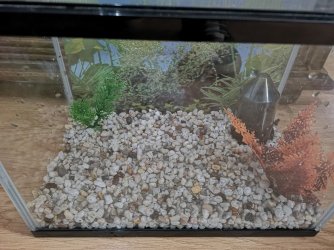I am not sure if anyone has addressed the addition of river rocks to your aquarium yet or not. To be honest I didn't read through the entire thread as it was fairly long, so if someone has already mentioned this, my apologies!
You should use caution when adding rocks that you have collected from the environment to your aquarium. When you purchase rocks from a Pet Store, you likely can be sure that they are safe, but when you add rocks that you have collected you have no way of knowing what kind of rocks they are. Some types of rocks (such as limestone and some granite) are calcareous (contains calcium as calcium carbonate) and are known for their ability to both harden the water and increase the pH. In fact, if someone wants to raise water pH in their aquarium, one method that can be used is to place crushed limestone, coral, oyster shell or any highly calcareous material in the filter. The calcium carbonate leaches into the water and alter the hardness (GH) and pH of the water.
That being said, it does not mean that you can't add rocks to your tank that you have collected from the environment. You will just need to test the rocks that you collect to determine if they contain calcium carbonate. Some people use Vinegar to test their rocks by adding several drops to the surface of the rocks. Vinegar is a weak acid and will react with calcium carbonate by fizzing. However, because vinegar is a
weak acid, it only visibly reacts if the calcium carbonate concentration in the rock is high, so it is not always reliable in determining if a rock contains calcium carbonate. There is a better method for testing rocks that is very easy and you may already have what you need to perform the test. If you have API's Master Test Kit already, then you have the means to test the rocks you collect. Bottle #1 for Nitrates in the API Master Test Kit contains a stonger acid (I believe it is hydrochloric acid?) and will more reliably react with any calcium carbonate present in rocks. Just add several drops on the rock and watch for fizzing or bubbling. If you see bubbling or fizzing, do NOT use the rock, unless you want to raise the GH or pH of your tank water. If you do not observe any fizzing or bubbling, then the rock should be safe to add to your aquarium. Just make sure to wash and scrub it thoroughly after testing and before adding it to your aquarium.
I used this method myself, and it definitely works! Some of the rocks I collected reacted quite a bit when I added the drops from the Bottle #1 for Nitrates, so I did not use these rocks in my tank. Other rocks did not react at all, so these are the ones I currently have in my aquarium.
I hope this helps!





